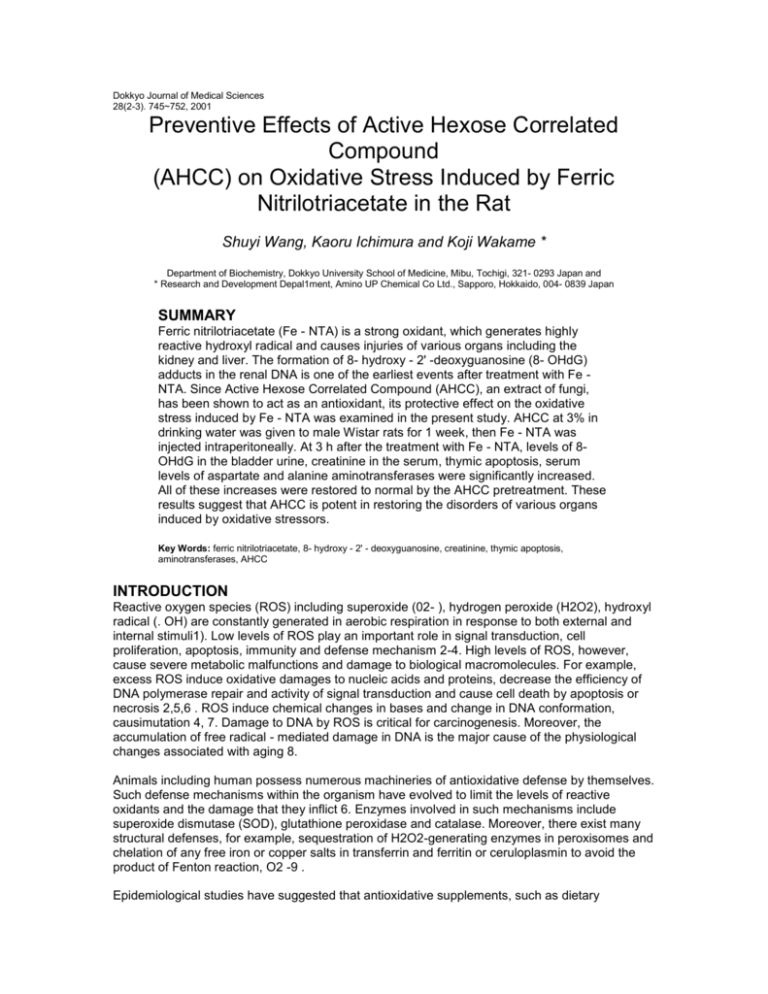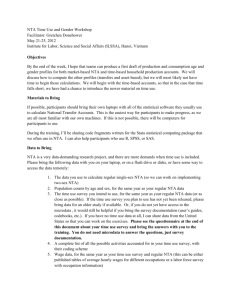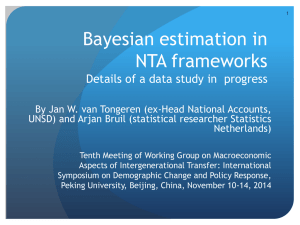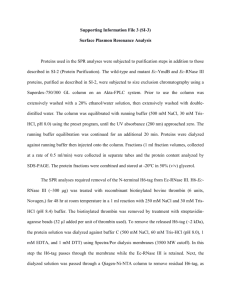Dokkyo Journal of Medical Sciences
advertisement

Dokkyo Journal of Medical Sciences 28(2-3). 745~752, 2001 Preventive Effects of Active Hexose Correlated Compound (AHCC) on Oxidative Stress Induced by Ferric Nitrilotriacetate in the Rat Shuyi Wang, Kaoru Ichimura and Koji Wakame * Department of Biochemistry, Dokkyo University School of Medicine, Mibu, Tochigi, 321- 0293 Japan and * Research and Development Depal1ment, Amino UP Chemical Co Ltd., Sapporo, Hokkaido, 004- 0839 Japan SUMMARY Ferric nitrilotriacetate (Fe - NTA) is a strong oxidant, which generates highly reactive hydroxyl radical and causes injuries of various organs including the kidney and liver. The formation of 8- hydroxy - 2' -deoxyguanosine (8- OHdG) adducts in the renal DNA is one of the earliest events after treatment with Fe NTA. Since Active Hexose Correlated Compound (AHCC), an extract of fungi, has been shown to act as an antioxidant, its protective effect on the oxidative stress induced by Fe - NTA was examined in the present study. AHCC at 3% in drinking water was given to male Wistar rats for 1 week, then Fe - NTA was injected intraperitoneally. At 3 h after the treatment with Fe - NTA, levels of 8OHdG in the bladder urine, creatinine in the serum, thymic apoptosis, serum levels of aspartate and alanine aminotransferases were significantly increased. All of these increases were restored to normal by the AHCC pretreatment. These results suggest that AHCC is potent in restoring the disorders of various organs induced by oxidative stressors. Key Words: ferric nitrilotriacetate, 8- hydroxy - 2' - deoxyguanosine, creatinine, thymic apoptosis, aminotransferases, AHCC INTRODUCTION Reactive oxygen species (ROS) including superoxide (02- ), hydrogen peroxide (H2O2), hydroxyl radical (. OH) are constantly generated in aerobic respiration in response to both external and internal stimuli1). Low levels of ROS play an important role in signal transduction, cell proliferation, apoptosis, immunity and defense mechanism 2-4. High levels of ROS, however, cause severe metabolic malfunctions and damage to biological macromolecules. For example, excess ROS induce oxidative damages to nucleic acids and proteins, decrease the efficiency of DNA polymerase repair and activity of signal transduction and cause cell death by apoptosis or necrosis 2,5,6 . ROS induce chemical changes in bases and change in DNA conformation, causimutation 4, 7. Damage to DNA by ROS is critical for carcinogenesis. Moreover, the accumulation of free radical - mediated damage in DNA is the major cause of the physiological changes associated with aging 8. Animals including human possess numerous machineries of antioxidative defense by themselves. Such defense mechanisms within the organism have evolved to limit the levels of reactive oxidants and the damage that they inflict 6. Enzymes involved in such mechanisms include superoxide dismutase (SOD), glutathione peroxidase and catalase. Moreover, there exist many structural defenses, for example, sequestration of H2O2-generating enzymes in peroxisomes and chelation of any free iron or copper salts in transferrin and ferritin or ceruloplasmin to avoid the product of Fenton reaction, O2 -9 . Epidemiological studies have suggested that antioxidative supplements, such as dietary antioxidants of small molecules, including vitamin C (ascorbate), vitamin E (tocopherol) and carotenoids are potent in preventing carcinogenesis 10, 11. Thus, natural plant components have been expected to provide oxidative defenses against cancer and degenerative diseases caused by oxidative stress. Active Hexose Correlated Compound (AHCC™ Amino UP Chemical Co. Ltd. Sapporo) is a mixture of polysaccharides, amino acids and minerals derived from fungi. It is obtained by hot water extraction after culturing mycelia of several basidiomycetes in a liquid culture tank and treating them with several enzymes 12. The main active component of AHCC is a mixture of oligosaccharides whose average molecular weight is approximately 5,000 12, 13. The chemical analysis has revealed that polysaccharides are the major components of AHCC, consisting pproximately 74%. Nearly 20% of ti1e polysaccharides are a- 1, 4- glucan and its acetylated forms, which are thought to be active components 12. AHCC also contains some other polysaccharides including ß- glucans. Both a- and ß- glucans are shown to be responsible for the antitumor effects of Basidiomycetes 14. It has been reported that this extract shows various beneficial effects in humans and in experimental animals acting either as a biological response modifier (BRM) or an antioxidant. It was shown that AHCC was effective in suppressing growth of experiment cancers in mice and rats such as SST- 2 tumor and breast cancer l3. AHCC enhances a helper T cell 1 (Th1) response in susceptible BALB/c mice, speciaIly increasing interleukin (IL) - 12 levels 15). It was also found out that Th1 cytokines levels such as tumor necrosis factor (TNF) - a and interferon (IFN) - y were increased in response to AHCC treatment. AHCC is used clinically as a successful complementary therapy for cancer patients 16. AHCC treatment after surgical operation could improve the quality of life (QOL) of patients with malignant tumors and increase ti1e survival rate by inhibiting tumor metastasis 16. AHCC can also prevent the onset of the diabetes induced by streptozo-tocin 17. Recently, we have found that AHCC suppresses thymic apoptosis induced by dexamethasone 18 , suggesting that AHCC acts as an antioxidant. Ferric nitrilotriacetate (Fe - NTA) is a chemical that induces severe oxidative damage by Fenton reaction, in which the very reactive hydroxyl radical is generated19~23. It acts as a potent nephrotoxin, causing high incidence of renal cell carcinoma in rats and mice8, 20, 24 . Fe - NTA treatment results in renal DNA damage, including formation of 8 - hydroxy - 2' - deoxyguanosine (8-OHdG) in the renal DNA through the generation of active oxygen radicals. The increase in urinary excretion of 8- OHdG reflects the oxidative DNA damage in vivo 19, 25. Creatinine levels in the serum are significantly increased following Fe - NTA treatment 19, 23i. Fe- NTA also can induce hepatic injuries acting through the generation of R0S26. These damages done to several organs are ameliorated by antioxidants27, 28. The objective of our present study is to examine whether or not AHCC has the preventive effects on the damage induced by oxidative stress in rats treated with Fe- NTA. Our present study deals with the beneficial effects of AHCC on the damage of various organs induced by Fe - N1'A. MATERIALS AND METHODS 1. Materials. Lyophilized AHCC was prepared by Amino UP Chemical Co. Ltd. (Sapporo, Japan). Fe -NTA solution was prepared immediately before use as previously described22). Nuclease P1 was obtained from Sigma (St. Louis, MO, USA). 2. Animals. Studies with the rats were approved by Animal Care and Use Committee, Dokkyo University School of Medicine. The animals were treated according to guidelines for the Care and Use of Laboratory Animals of ti1e Committee. Male Wistar rats of 8- weeks old were purchased from Charles River Japan Inc. (Kanagawa. Japan). The animals were kept in a room at 23 ± 2ºC with 12 h light and dark cycle and kept free access to food and water. Twenty- one rats were divided into four groups. Two groups received 3% AHCC as a drinking water for a week. The concentration of AHCC and the duration of the treatment were chosen according to our previous results 18. Control groups received only tap water for a week. Fe - NTA (15 mg/kg body weight as Fe3 + was injected intraperitoneally to two groups; one of them was AHCC - pretreatment group, and the other was the control group. Fe - NTA effects at this dose were maximal at 3h of the treatment as shown by others 27.28. 3. Blood sampling and organ preparation. Rats were sacrificed by decapitation at 3h after Fe NTA-treatment. Blood samples were collected into sampling tubes. Serum samples were obtained after centrifuging at 4ºC for 15 min at 3,000 rpm. The sera thus obtained were used for the assay of serum aminotransferases and creatinine. Thymus glands were removed and washed in cold phosphate - buffer solution (PBS), then put into the tubes which contained collagenese- EDTA for apoptosis assay. Urine samples were taken from urinary bladder of rats for 8- OHdG assay. 4. 8- OHdG assay in the urine. Urine samples were centrifuged at 10,000 rpm, and the supernatant was used for ELISA analysis. 8- OHdG was assayed by ELISA kits, which were prepared by Japan Institute for the Control of Aging (Shizuoka, Japan) . 5. Detection of apoptosis by flow cytometry. Cell suspensions were obtained after collagenase EDTA (0.25% in PBS) treatment and filtration through nylon mesh. The cell suspensions were washed with PBS (pH 7.4), adjusted to a concentration of 1.5 x 106 cell/mL.Then the cells were centrifuged at 200 x g for 5 min. The 200 x g centrifuged cell pellet was gently resuspended in1.5 mL hypotonic fluorochrome solution containing propidium iodide (PI, 50 µg/mL in 0.1% sodium citrate plus 0.1% Triton x 100) , in polypropylene tubes. The tubes were placed at 4ºC in the dark overnight before the flow cytometric analysis. Flow cytometry was carried out by analyzing 10,000 cells per test using a FACSCalibur (Becton Dickinson, Mountain View, CA, USA). 6. Creatinine and aminotransferase assays. Creatinine in the serum was assayed by creatinine kit. The activity of alanine aminotransferase (ALT) , aspartate aminotrans- ferase (AST) in the serum were routinely assayed by commercial kits. 7. Statistical analysis. All the data were expressed as mean ± SEM. Analysis of variance (ANOVA) was performed and Scheffe's multiple comparison test was applied to test for the differences between individual groups. A, p value less than 0.05 was considered statistically significant. RESULTS 1. 8- OHdG in the bladder urine First we observed the noxious effects of Fe - NTA in the kidney and the effects of simultaneous administration of Fe- NTA and AHCC on the renal function. 8OHdG in the bladder urine increased significantly at 3 h after treatment with Fe - NTA. A significantly lower level of 8 - OHdG in the urine of AHCC pretreated rats was observed, when compared with that of the rats treated with Fe - NTA alone (Fig. 1). 2. Creatinine in the serum The enhanced serum creatinine levels, which depend on glomeruler filtration rate, are indicative of renal injury22. 23. In our experiment, the creatinine levels in the serum increased significantly in the rats treated with Fe- NTA treatment alone, while AHCC pretreatment restored the increased levels to normal (Fig. 2). 3. Thymic apoptosis Thymic apoptosis in the Fe- NTA treated rats increased significantly compared with that in the control and AHCC groups. Thymic apoptosis in the Fe- NTA -AHCC treated rats was much lower than in the rats treated with Fe - NTA alone (Fig. 5). 4. Serum AST and ALT Hepatic injuries induced by Fe - NTA were assessed by measuring the activity of serum aminotransferases. The serum levels of AST and ALT were elevated in the Fe NTA- treated group than those in the control and AHCC groups (Figs. 3, 4). AHCC - pretreatment decreased AST and ALT levels in the serum significantly to the normal levels. DISCUSSION The results of the present study have shown that Fe -NTA increases the urinary levels of 8OHdG, and serum levels of creatinine, AST and ALT. All these changes induced by Fe - NTA have already been observed by others, showing that this toxin damages both the kidney and the liver 19, 22. 23. In the present study it was first shown that thymic apoptosis was induced by this chemical. These changes may be closely associated with oxidative stress, because Fe - NTA produces ROS in vivo. All the Fe - NTA - induced changes observed here are restored to normal by the pretreatment with AHCC for 1 week. The results seem to suggest that AHCC can protect damages of various organs caused by ROS. Fe - NTA is a renal toxicant and carcinogen in rats and mice 20, 24. This chemical increases markedly the urinary excretion of 8- OHdG which is a useful marker for measuring the level of oxidative D NA damage19, 25. The damage in DNA is closely associated with aging and carcinogensis 8, 19, 20, 23, 24. A common form of DNA damage is the formation of hydroxylated bases, which is considered to be an important event in carcinogenesis induced by oxidative stress. The formation of 8- OhdG has been shown to be suppressed by antioxidants such as vitamin E, vitamin C and methionine 10, 11. Many other antioxidants have been shown to protect the injuries induced by Fe - NTA. For example, N - acetylcysteine (NAC), a precursor of intracellular cysteine and glutathione, prevents renal damage induced by Fe - NTA in the rat 28. Alpha- tocopherol, a lipid- soluble antioxidant, ameliorates renal proliferative response and toxicity induced by Fe - NTA 27. AHCC decreased the Fe - NTA - increased 8- OHdG levels in the urine, suggesting that this compound prevents mutation by scavenging ROS. It is reported that Fe - NTA increases the hepatic ornithine decarboxylase (ODC) and that the pretreatment of rats with butylhydroxytoluene (BHT), an antioxidant, suppresses the increase in the enzyme activity26 . Fe -NTA injected intraperitoneally into rats increasea plasma levels of the two aminotransferases, ALT and AST and AHCC pretreatment normalized the elevated enzyme activities. These findings suggest that AHCC protect the hepatic damage induced by oxidative stress of Fe - NTA. Thymic apoptosis is induced by glucocorticoids and oxidative stress and suppressed by antioxidants such as melatonin30. Recently we have found that AHCC suppresses thymic apoptosis induced by dexame-thasone 18. All these findings suggest that AHCC acts as an antioxidant. It is not known yet if AHCC acts directly as an antioxidant to scavenge ROS or induces some enzymes, which cleavage ROS. It still remains unclarified which components of AHCC are responsible for its protective effect against oxidative stress. Our preliminary experiments have revealed that AHCC itself has no antioxidant effect on thymocytes in vitro (data not shown). The study is currently under way to test the effects of individual a- and - ß glucans purified from AHCC. Acknowledgments. The authors are thanks for Prof. S. Matsuzaki, Department of Biochemistry -, Dokkyo University School of Medicine for his critical review of our paper. Thanks are also due to Amino UP Chemical Co. Ltd. for the supply of AHCC. This study was supported in part by research grants from Tsukushi Foundation. Fig. 1: Effects of Fe - NTA and AHCC on 8 - OhdG levels in urinary bladder urine. Urine samples in the urinary bladder were withdrawn immediately after sacrifice. Fe- NTA (15 mg Fe 3+/Kg) was injected i.p. 3h before experiment. AHCC at 3% in drinking water was given for a week. Data are shown as means ± SEM with the numbers of determination in parentheses. *, p< 0.001 vs. control group. a, p< 0.001 vs. AHCC + Fe-NTA group. Abbreviations are as follows: FNT, Fe-NTA, ferric nitrilotriacetate; AHCC, Active Hexose Correlated Compound and 8 - OhdG, 8 - hydroxyl - 2'- deoxyguanosine Fig. 2: Effects of Fe - NTA and AHCC on serum creatinine levels. Creatinine in the serum were assayed by creatinine kit. Data are shown as means ± SEM with the numbers of determination in parentheses. Fig. 3: Effects of Fe - NTA and AHCC on serum alanine aminotransferase (ALT) levels. ALT was assayed by commercial kit. Data are shown as means ± SEM with the numbers of determination in parentheses. *, p< 0.001 vs. control group. a, p< 0.001 vs. AHCC + Fe-NTA group. Fig. 4: Effects of Fe - NTA and AHCC on serum aspartate aminotransferase (AST) levels. AST was assayed by commercial kit. Data are shown as means ± SEM with the numbers of determination in parentheses. *, p< 0.001 vs. control group. a, p< 0.001 vs. AHCC + Fe-NTA group. Fig. 5: Effects of Fe - NTA and AHCC on the thymic apoptosis. Apoptosis was estimated by flow cytometry using FACSCalibur. Data are shown as means ± SEM with the numbers of determination in parentheses. *, p< 0.001 vs. control group. a, p< 0.001 vs. AHCC + Fe-NTA group. REFERENCES 1) Lee Y, Galoforo SS, Berns CM, et al: Glucose deprivation - induced cytotoxicity and alterations in mitogen - activated protein kinase activation are mediated by oxidative stress in multidrug - resistant human breast carcinoma cells. J Biol Chem, 273: 5294- 5299, 1998. 2) Schulze - Osthoff K., Bauer MK, Vogt M, et al: Oxidative stress and signal transduction. Int J Vitam Nutr Res, 67 : 336- 342, 1997. 3) Sun J, Chen Y, Li M et al: Role of antioxidant enzymes on ionizing radiation resistance. Free Rad Biol Med, 24: 586- 593, 1998. 4) Vogt M, Bauer K, Ferrari K, et al : Oxidative stress and hypoxia/reoxygenation trigger CD95 (APO- 1/Fas) ligand expression in microglial cells. FEBS Lett, 429: 67- 72, 1998. 5) Baynes JW. : Role of oxidative stress in development of complications in diabetes. Diabetes, 40: 405- 412, 1991. 6) Sies H.: Oxidative Stress: Oxidants and Antioxidants. Academic Press, Orlando, Florida, 1991. 7) Burton K. A study of the conditions and mechanism of the diphenylamine reaction for the colorimetric estimation of deoxyribonucleic acid. Biochem J, 62 : 315- 323, 1956. 8) Harman D.: The aging process. Proc Natl Acad Sci, USA, 78: 7124- 7128, 1981. 9) Biemond P, Van Eijk HG, Swak AJG, et al: Iron mobilization from ferritin by superoxide derived from stimulated polymorphonuclear leukocytes: possible mechanism in inflammation diseases. J Clin Invest, 73: 1576- 1579, 1984. 10) Bendich A and Butterworth CE Jr.: Micronutrients in Health and in Disease Prevention. Marcel Dekker, New York, 1991. 11) Gridley G, McLaughlin JK, Block G, et al: Vitamin supplement use and reduced risk of oral and pharyngeal cancer. Am J Epidemiol, 135: 1083- 1092, 1992. 12) Kosuna K.: Recent progress of research on AHCC. New Food Industry, 41: 17- 23 (in Japanese), 1999. 13) Matsushita K, Kuramitsu Y, Ohiro Y, et al : Combination therapy of Active Hexose Correlated Compound plus UFT significantly reduces the metastasis of rat mammary adenocarcinoma. Anti Cancer Drugs, 9: 343- 350. 1998. 14) Mizuno T and Kawai M.: Chemistry and Biochemistry of Mushroom (in Japanese). Japan Science Society Press, Tokyo, pp 35- 45, 1995. 15) Yagita A, Maruyama S and Sukegawa Y.: Effective of the natural IL- 12 inducers on various progressive cancers (Abst). AHCC Research Association 7th Symposium p. 15, 1999. 16) Matsui Y, Kawaguchi Y and Kamiyama Y.: Effects of AHCC as a complemel1tary therapy on prognosis of postoperative hepatocellular carcinoma patients (Abst). AHCC Research Association 7th Symposium, p. 16, 1999. 17) Wakame K.: Protective effects of Active Hexose Correlated Compound (AHCC) on the onset of diabetes induced by streptozotocin in the rat. Biomed. Res, 200 145- 152, 1999. 18) Burikhanov RB, Wakame K, Igarashi Y, et al: Suppressive effect of Active Hexose Correlated Compound (AHCC) on thymic apoptosis induced by dexamethasone in the rat. Endocrine Regulat, 34: 181- 188, 2000. 19) Kasai H.: Analysis of a form of oxidative DNA damage, 8- hydroxy - 2' - deoxyguanosine, as a marker of cellular oxidative stress during carcinogenesis. Mutation Res, 387: 147- 163,1997. 20) Okada S and Midorikawa S.: Induction of rats renal adenocacinoma by ferric nitrilotriacetate. Jpn Arch Intenal Med, 29. 485- 491 (in Japanese), 1982. 21) Tanaka T, Nishiyama Y, Okada K, et al: Induction and nuclear translocation of thioredoxin by oxidative damage in the mouse kidney: independence of tubular necrosis and sulfhydryl depletion. Lab Invest, 77: 145 - 55, 1997. 22) Toyokuni S, Uchida K, Okamoto K, et al: Formation of 4- hydroxy - 2- nonenal - modified proteins in the renal proximal tubules of rats treated with a renal carcinogen, ferric nitrilotriacetate. Proc Natl Acad Sci, USA. 91: 2616- 2620, 1994. 23) Umemura T, Sai K, Takagi A, et al: Formation of 8 - hydroxydeoxyguanosine (8- OHdG) in rat kidney DNA after intraperitoneal administration of ferric nitrilotriacetate (Fe - NTA). Carcinogenesis. 11: 345- 347.1990. 24) Floyd RA. : 8- Hydroxy - 2' - deoxyguanosine in carcinogenesis. Carcinogenesis, 11: 14471450, 1990. 25) Shigenaga MK. Gimeno CJ and Arnes BN: Urinary 8 - hydroxy - 2' - deoxyguanosine as a biological marker of in vivo oxidative DNA damage. Proc Natl Acad Sci, USA, 86: 9697- 9701, 1989. 26) Iqbal M, Giri U and Athar M.: Ferric nitrilotriacetate is a potent hepatic tumor promoter and acts through the generation of oxidative stress. Biochem Biophys Res Commun, 212: 557- 563, 1995. 27) Iqbal M, Rezazadeh H, Ansar S, et al: Alpha -Tocopherol ameliorates ferric nitrilotriacetate (Fe -NTA) - dependent renal proliferatjve response and toxicity: diminution of oxidative stress. Hum Exptl Toxicol. 17:163- 171. 1998. 28) Umemura T, Hasegawa R. Sai- Kato K. et al : Prevention by 2- mercaptoethane sulfonate and N -acetylcyteine of renal oxidative damage in rats treated with ferric nitrilotriacetate. Jpn J Cancer Res, 87: 882 - 886, 1996. 29) Gallagher SR.: Quantitation of DNA and RNA with absorption and fluorescence spectroscopy. In: Ausubel I, Frederick M (eds) Current Protocols in Molecular Biology. John Wiley & Sons, New York, pp. A. 3D. 1 - A 3D.8, 1992. 30) Saimz RM. Mayo JC, Uria H, et al: The pineal neurohormone melatonin prevents in vivo and in vitro apoptosis in thymocytes. J Pineal Res, 19: 1 76- 188, 1995.






